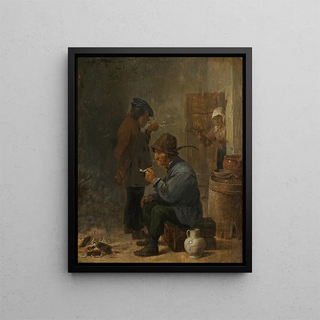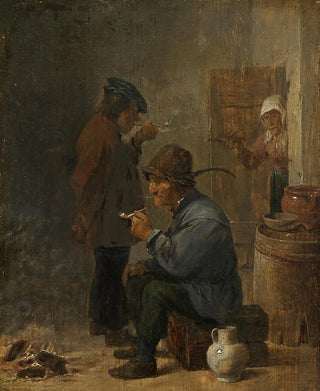Art print | Two peasant smokers by the charcoal fire - David Teniers the Younger


View from behind

Frame (optional)
In the fascinating world of Flemish baroque art, the artwork "Two peasants smoking by the charcoal fire" by David Teniers the Younger stands out for its intimate and warm depiction of rural life. This painting, which immerses the viewer in a moment of conviviality, brilliantly illustrates the simplicity and beauty of everyday moments. The two peasants, absorbed in their activity, evoke an atmosphere of calm and sharing, as if time had paused around their fire. Through this piece, Teniers invites us to appreciate the richness of genre scenes, where every detail, from the smoke rising slowly to the flickering light of the charcoal, contributes to creating an ambiance filled with realism and emotion.
Style and uniqueness of the work
Teniers' style is characterized by meticulous attention to detail and a palette of warm colors that breathe life into his characters. In "Two peasants smoking by the charcoal fire," the figures are dressed in typical period attire, their faces marked by labor and experience, while the play of light highlights the texture of the clothing and surrounding objects. The composition of the work, with its harmonious lines and visual balance, draws the eye toward the center of the scene, where the peasants share a moment of tranquility. Teniers excels in depicting human emotions, and here, he perfectly captures camaraderie and the simplicity of rural life. Every element, from kitchen utensils to shadows cast by the fire, contributes to the visual storytelling, demonstrating the artist's mastery in genre painting.
The artist and his influence
David Teniers the Younger, born in 1610 in Antwerp, is one of the most emblematic artists of 17th-century Flemish art. Son of a painter, he was trained in a rich artistic environment, which shaped his unique approach to painting. Teniers managed to establish himself on the artistic scene of his time thanks to his lively genre scenes and bucolic landscapes. His ability to capture daily life with a tender yet critical eye

Matte finish

View from behind

Frame (optional)
In the fascinating world of Flemish baroque art, the artwork "Two peasants smoking by the charcoal fire" by David Teniers the Younger stands out for its intimate and warm depiction of rural life. This painting, which immerses the viewer in a moment of conviviality, brilliantly illustrates the simplicity and beauty of everyday moments. The two peasants, absorbed in their activity, evoke an atmosphere of calm and sharing, as if time had paused around their fire. Through this piece, Teniers invites us to appreciate the richness of genre scenes, where every detail, from the smoke rising slowly to the flickering light of the charcoal, contributes to creating an ambiance filled with realism and emotion.
Style and uniqueness of the work
Teniers' style is characterized by meticulous attention to detail and a palette of warm colors that breathe life into his characters. In "Two peasants smoking by the charcoal fire," the figures are dressed in typical period attire, their faces marked by labor and experience, while the play of light highlights the texture of the clothing and surrounding objects. The composition of the work, with its harmonious lines and visual balance, draws the eye toward the center of the scene, where the peasants share a moment of tranquility. Teniers excels in depicting human emotions, and here, he perfectly captures camaraderie and the simplicity of rural life. Every element, from kitchen utensils to shadows cast by the fire, contributes to the visual storytelling, demonstrating the artist's mastery in genre painting.
The artist and his influence
David Teniers the Younger, born in 1610 in Antwerp, is one of the most emblematic artists of 17th-century Flemish art. Son of a painter, he was trained in a rich artistic environment, which shaped his unique approach to painting. Teniers managed to establish himself on the artistic scene of his time thanks to his lively genre scenes and bucolic landscapes. His ability to capture daily life with a tender yet critical eye






